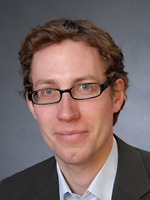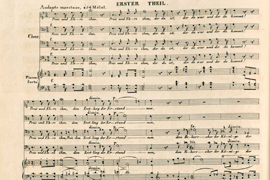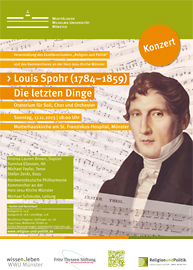Researchers Discover Musical History Treasure
Database for the first time gathers German oratorios as of 1800 – conference at the Cluster of Excellence “Religion and Politics” examines oratorios by Louis Spohr – public performance of the oratorio “Die letzten Dinge” (Last Things) in Münster on 17 November
Press release of the Cluster of Excellence, 11. November 2013

Dr. Dominik Höink
At the University of Münster’s Cluster of Excellence “Religion and Politics”, a forgotten treasure of musical history is being discovered: researchers gather and examine oratorios of the 19th and 20th centuries. In contrast to their sister genre, opera, these have still often barely been studied, as musicologist Dr. Dominik Höink explains. Attention has so far been focused on few oratorios such as those by Joseph Haydn (1732-1809) and Felix Mendelssohn Bartholdy (1809-1847). Apart from these, there is an “immense research gap” as regards German works of this genre. The oratorios of composer Louis Spohr (1784-1859), therefore, are as yet inadequately researched. An interdisciplinary conference of the Cluster of Excellence and of the Institute for Musicology, taking place next week, will for the first time examine Spohr’s works in a systematic and interdisciplinary fashion. Conference organiser Höink will present a database which gathers, for the first time, all German oratorios between 1800 and the middle of the 20th century.
Everybody is invited to attend the public performance of the oratorio “Die letzten Dinge” (Last Things) by Louis Spohr on 17 November at 6 p.m. at the Mutterhauskirche of the Franciscans. The concert in the context of the conference, which international experts are expected to attend from 15 to 17 November, is to convey an acoustic impression of Spohr’s musical oeuvre. Renowned soloists such as soprano singer Andrea Lauren Brown, alto singer Sunniva Eliassen, tenor Michael Feyfar and bass singer Stefan Zenkl will sing together with the Herz-Jesu-Kirche Münster’s chamber choir and the Nordwestdeutsche Philharmonie, under the musical direction of Michael Schmutte. Tickets may be obtained in advance from Musikhaus Viegener, Katthagen 25-26; Copy-Casa, Wolbecker Straße 91; and online at kammerchor-herz-jesu.de.

Beginning of the opening choral of Spohr’s oratorio “Die letzten Dinge”
“Spohr’s oratorios, like the work ‘Die letzten Dinge’, which is about the Last Judgement and the second coming of Jesus Christ, are almost irrelevant on the current concert stage”, says Höink. This, however, does not at all reflect the importance of the works for German musical culture in the 19th century. “On the contrary: Spohr’s contemporaries hailed him as a virtuoso violinist and composer.” According to the Cluster of Excellence’s musicologist, who investigates the oratorio as a medium of political messages, the appeal of Spohr’s oratorios lies in the interplay of religious musical genre and political context. “During the lifetime of Spohr, the French Revolution of 1789, Napoleon’s occupation of the German states, and the Revolutions of 1848 in the German states took place – an eventful time, which found expression in his works.” In 1812, for example, he composed the first oratorio, “Das jüngste Gericht” (Last Judgement), in honour of the French emperor. In his second oratorio “Die letzten Dinge” (Last Things, 1826), however, he captured the apocalyptic mood after the German Campaign (1813-1815). At the conference “Die Oratorien Louis Spohrs. Kontext – Text – Musik” (The Oratorios of Louis Spohr. Context – Text – Music), musicologists and literary scholars together with theologians will examine Spohr’s works and their origins more closely and discuss the composer’s importance for the history of the oratorio.
Database is to close research gap
In the 19th century, the oratorio was often used for political messages, as the musicologist explains. “Originally, the oratorio – in contrast to opera – served above all prayer and religious edification, but it had increasingly been affiliating with nationalism since the 19th century.” According to Höink, the works were performed at music festivals, which had an important social function as venues of sociality and which became forums of political exchange. “The oratorios, which treated historical figures compositionally, contributed to collectivisation and looked back on earlier victories in war. By means of dedications, figures such as Widukind, King of Saxony, or Otto the Great could be associated with the political present.”

The VDOra database (Verzeichnis der deutschen Oratorien; index of German oratorios), which Höink will present at the conference together with his colleagues Robert Memering, Münster, and Prof. Dr. Rebekka Sandmeier, Cape Town, aims at providing an overview of the entire German oratorio repertoire. “The objective is to document works, performance data and research literature as comprehensively as possible and to make this available on-line.” Thus, according to the expert, over 8,000 oratorio performances in the 19th century alone could be established. VDOra is developed in cooperation with the research project of musicologist Höink at the Cluster of Excellence, B2-9 Politico-National Material in a Spiritual Religious Form – Oratorio Composition from the 18th to the 20th Century, and the South African College of Music at the University of Cape Town. The database is to be made available on the Internet in 2015.
The conference “Die Oratorien Louis Spohrs. Kontext – Text – Musik” (The Oratorios of Louis Spohr. Context – Text – Music) will begin on 15 November in the Cluster of Excellence’s lecture building at Johannisstraße 4. It is also supported by the Fritz Thyssen Foundation. The conference members will examine Spohr’s four oratorios: “Das jüngste Gericht”, “Die letzten Dinge”, “Des Heilands letzte Stunden” and “Der Fall Babylons” (Last Judgement, Last Things, The Redeemer’s Final Hours, The Fall of Babylon). Further contributions will investigate Spohr’s autobiographical (self-) staging as well as the socio-historical and cultural-historical background. According to Höink, this multi-perspectivity in the approach to Spohr’s oratorios is to bring forth new insights also as regards a wider context of the 19th-century genre history. (ska/vvm)

